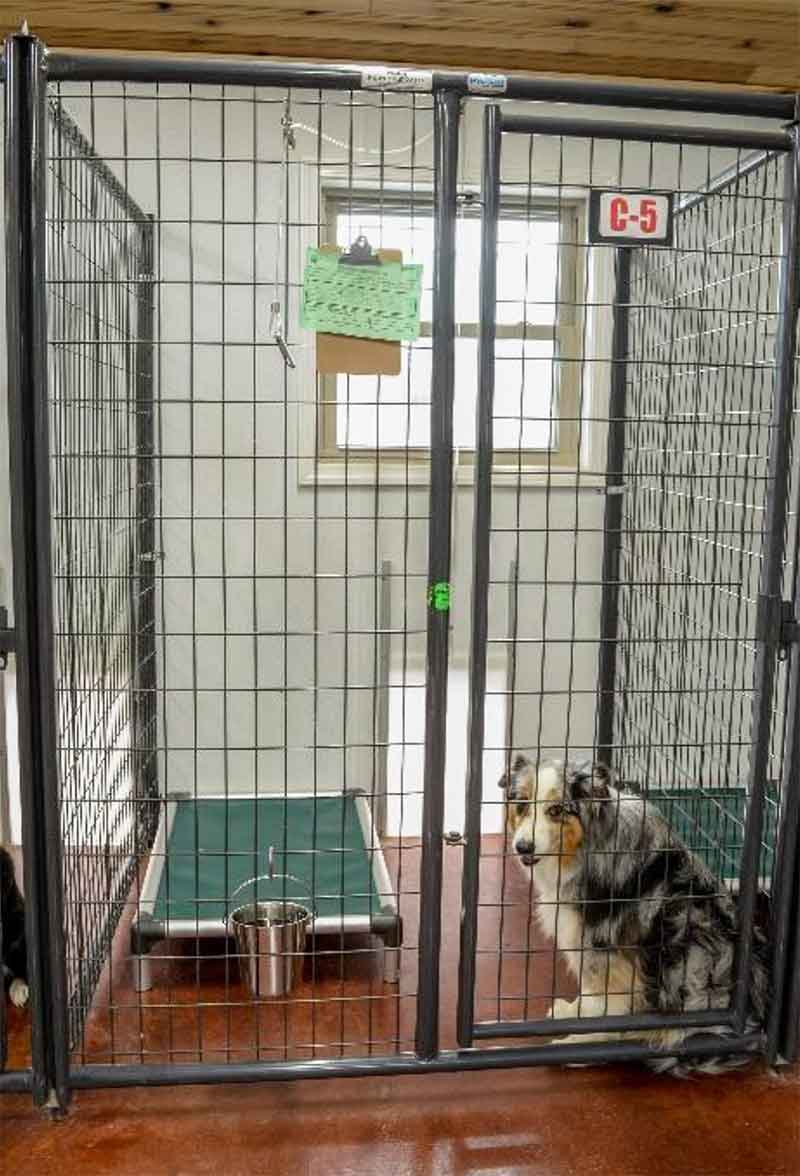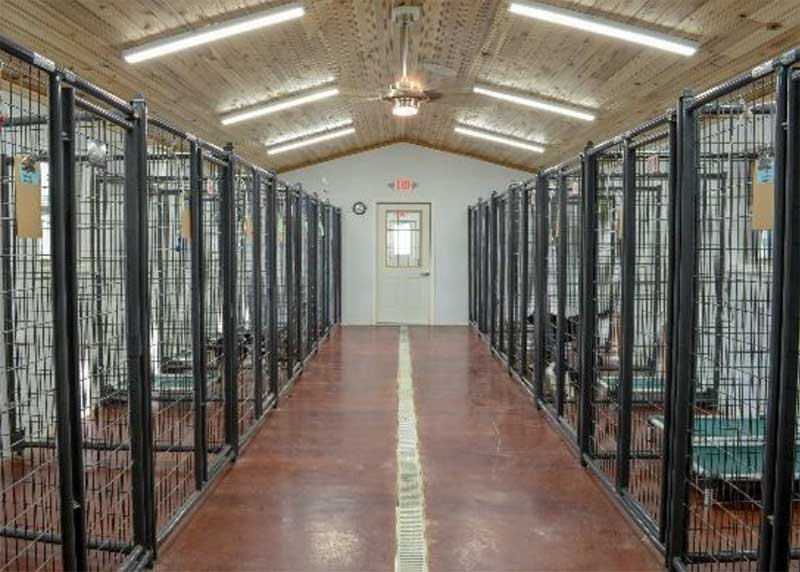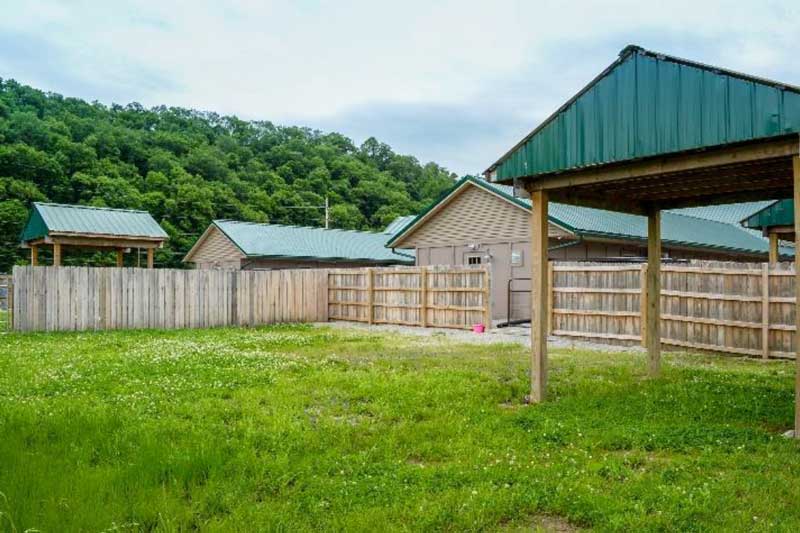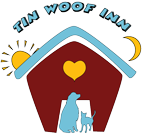People want to go on vacation and can’t take their dog. Business trip. People get sick and there is no one to take care of their dog. Grandma is coming for Christmas and the dog always chews up her cane. Whatever the need, about 1 in 7 pet owners need to board their dog every year. But how do you choose the best place for your pet? In the past many people just took their pet to the vet. Over the years facilities like Tin Woof Inn, dedicated to pet boarding, have sprung up. Nothing against many of our friends who are veterinarians, but their facilities are built to house sick and injured animals and by definition their housing is meant to confine the animal to prevent further injury. Many people don’t want their dog in a cage next to a sick dog. One of the best things you can do is to go tour a facility. See if it “feels” right. Fortunately, the are some more objective criteria to consider when looking over a temporary home for your cherished family member.

Welded wire panels from Priefert and FRP wall coverings at Tin Woof Inn Ashland.
Is the facility designed and built to provide a comfortable and safe stay for your dog? Poorly designed, dated, poorly maintained facilities simply can’t deliver a quality stay for your pet no matter how hard they try. It is like putting lipstick on a pig, it is still a pig! Some things to look for:
- Chain link kenneling and fencing is common, but it is a terrible material to use in a boarding environment. It has sharp points at the top and bottom which can injure your dog (digging or jumping). Many dogs can bite through chain link and cause severe injury to their teeth, lips, jaw and mouth. It is porous so it is hard to clean, and it rusts. A far better material to use for kenneling is welded powder coated wire or stainless steel. Welded wire panels, like the ones used at Tin Woof Inn, cost about the same as chain link ($150-$250 per panel). Stainless steel costs upwards of $500 per panel. You will easily pay $5-$10 more per night for facilities that overspend on stainless steel.
- Walls are very often concrete block. It is cheap, tough and a bad idea. It is porous, and very difficult to clean and sanitize. In addition, most block buildings are not insulated, creating a warmer environment in the summer and a colder one in the winter, with higher heating and air conditioning bills (which get passed on through your boarding bill). Many facilities paint the block to reduce the porosity. Bad idea. When cleaning the block with a power washer, chips of paint will come loose, spreading germs even more widely. A far better material is FRP (Fiberglass Reinforced Panels). It is commonly used in restaurants because it is tough, non-porous, and cleans easily using a variety of safe cleaners. It is more expensive initially but much safer and ultimately more durable than block.

You will notice the drains running down the center aisle at our Frankfort facility.
- Drains: The reasons kennels smell is because there is debris (food, urine, feces, etc.) in the drains because they haven’t been cleaned. Drains placed inside a kennel, usually along the back wall, are notoriously prone to problems. Staff don’t clean these drains because it is such a hassle. They have to move the dog, move all the belongings, move food and water, take up the drain covers, and then hose down the drain. Then they have to replace the drain covers, move everything back into the kennel and bring the dog back, into a wet enclosure. This all takes several minutes. Then they move to the next kennel and repeat right down the line. It just doesn’t get done regularly, so the kennel smells. Also, dog food gets down in the drains and causes clogs then backups and often septic tank problems. If a dog has an illness that can be transmitted through its urine or feces, this gets into the drain and flows through several runs on its way to the actual drain. This can spread illnesses very quickly in these facilities. A far better design is where the drain is located in the aisle, outside of the actual kennel. These drains are far more easily cleaned (and therefore cleaned more often), won’t attract dog food and won’t transmit germs through all the kennels. Also, if a dog does urinate in the kennel it runs out of the enclosure, keeping the dog cleaner and drier.
- Play yards: There is no substitute for grass. It is soft, easier on a dog’s foot pads and is a more natural place for dogs to pee and poop. Concrete play areas get hot and are very hard on paw pads. Many dogs won’t pee or poop on concrete, creating other issues. The play yards should be dedicated to boarding dogs. We know of one operation in Eastern Kentucky where the dogs play in the horse pasture. There they can eat horse manure and get kicked by the horses (as reported to us by at least three of our new clients).
- Crate boarding: Dogs need to be kept in kennels not crates in a professional boarding environment. Sure, crates are great for home owners. But in a boarding kennel where dogs may stay for several days, they need the room a kennel provides. Crates are far more difficult to keep clean and require far more labor to maintain than kennel runs.
Look for the proper amenities:
- Dogs can get stressed in the boarding environment. It is new to them, there are other barking dogs and different sights and smells. There are many things boarding facilities can do to help reduce this stress: play background music (tends to sooths pets and reduces impact of storms, lightning and thunder), keep dogs on a regular schedule, provide exercise (through play times), provide beds (keeps dogs off cold floor), proper heating and cooling, lighting, ventilation, clean water, feed the dog’s normal food, avoid the use of harsh chemicals when dogs are present (bleach).
Ask about their policies and procedures:
- Feeding your dog’s own food is critical. If you want to have a dog with diarrhea in the kennel, change its food. Now you have an unhappy dog that is dehydrated as well!
- Ask how they give medications. They should keep a written log showing when meds were given and by whom. It is best to place the medication in a tasty food (pill pocket, cheese, canned food) and give directly to the dog. That way you know the dog actual took its medication. Simply placing a medication in the dish with the dog’s food doesn’t work. A dog can leave it in the bowl, hide it, or move it into the next kennel (so someone else’s dog gets your dog’s pill).
- How do they do playtimes? In most cases people don’t want their dog in a play group of 5, 10, or 20+ dogs. Dogs should be matched by age, breed, playstyles and the owner’s wishes. You don’t put a 1 year old rambunctious lab out in a play yard with an 8 year old Yorkie.
- Is the facility customer friendly with their days and hours of operation. Many small family owned kennels are not open on the weekends, or are closed on Sunday and Monday. That is their day off and they don’t have additional staff to run the place when they are gone.
- Do they require up to date vaccinations? No reputable kennel takes dogs that are not up on their routine vaccinations. Why? If a staff member gets bit, legally you have to have affirmative proof the dog has an up to date rabies vaccination. Otherwise the staff member must under go rabies shots, or they could die (no joke!). Rabies shots are expensive and painful. In some cases, the dog must be quarantined for 10 days to determine if it has rabies. Also, dogs that are vaccinated are protected against many common and serious diseases. Those that are not vaccinated are at risk. In a kennel environment where a dog is exposed to a number of other dogs, the odds of exposure to bad germs goes up.
- Water buckets are a must. Water bowls don’t work in a boarding environment. Dog jump up and tip them over, or splash water out of the bowl on to the floor, leaving them without water. Buckets should be large enough to contain a sufficient amount of water through the day and secured to the kennel to prevent them being tipped over.

Grass play yards with a shade cover at TWI Frankfort.
Listen for tell-tale phrases. Within the industry these are code words:
- “Free bath”, as in we give your dog a free bath before it goes home. That means they can’t keep you dog clean while it is in their facility. They may not have procedures in place, or a quality caring staff, to keep your dog from sitting in urine for hours on end.
- We “take your dog’s collar off” while in boarding. He will be more comfortable. How safe is it for a dog to be in a strange environment, with strange people, and lots of other dogs and no way for staff to identify the dog? Kennels often do this because they have chain link enclosures and your dog can literally hang himself by jumping up and getting his collar caught on the top of the chain link.
- When you look at a facility’s website do they have pictures of their play area and their kennels, or the front of the building? No pictures is a bad sign. No pictures means if you saw where your pet would be staying you wouldn’t come. We love the picture at one facility showing dogs playing in the play yard with dozens of headstones. The play yard is literally a grave yard. Oh, and if they don’t have a website, bad sign.
The vast majority of our clients have carefully chosen where they board their pets. They are trusting us with a cherished member of their family. Providing our clients and their pets with a superior boarding experience starts with a quality, well designed and built facility with great, experienced staff and sound policies and procedures to insure convenience for the client and safety for their pet. With more than 269,000 pet stay days at facilities we have designed, managed or owned we take our responsibility seriously and evidently we have earned the trust of most of our clients.
Scott Templeton and his wife Gale own 3 Tin Woof Inn locations (Morehead, Ashland, Frankfort). Scott has been in the pet industry professionally since 1993. He has designed, managed or operated nearly 20 pet facilities including two local pet shelters in Kentucky. He has supervised more than 269,000 pet stay days in his pet career. Prior to focusing on the pet industry he worked in senior marketing and operations management for 7-Eleven, Shell, Exxon-Mobil, Circle K, GTech and Intellimat in the US and UK. Scott and Gale live in Morehead with their 3 Australian Shepherds, 2 Border Collies and 3 cats.

